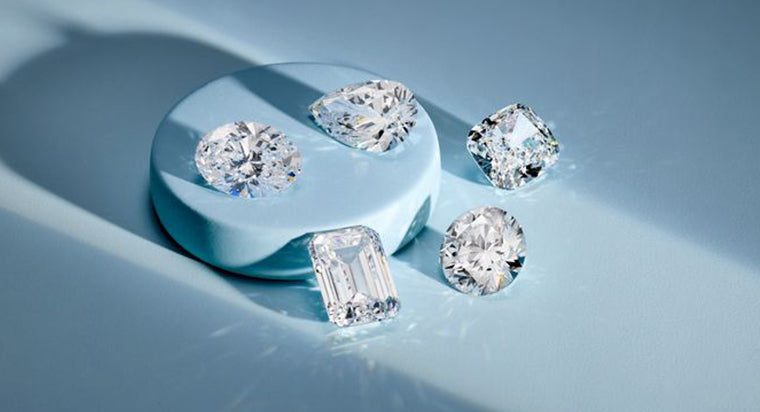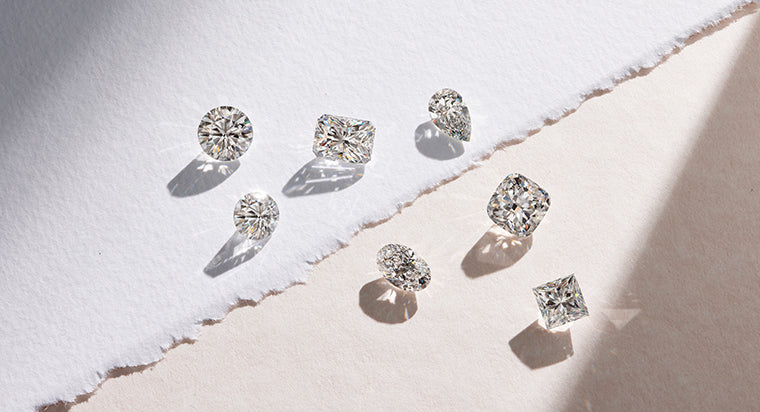How are Lab Diamonds Created?

Diamonds are perhaps one of the most sought after gems in the world, as they are great for any occasion and have a lasting impression on the recipient. When you give a diamond to someone, it says you care deeply and want to have a lasting connection with that person. When someone buys a diamond, it is with the knowledge of whether that diamond is natural or lab created. Many can have the opinion that lab created diamonds are not real, but they are as real as they can get. If they were placed side-by-side, one would not know the difference.
When it comes to sourcing or buying diamonds, one of the most important questions that’s asked is, whether if lab created diamonds are real. The answer is yes. Natural and lab diamonds are practically the same, with the price point and the origin of its creation being the only differences. Natural diamonds can go through millions of years to form within the earth, while lab created diamonds are grown by humans inside a building.
TABLE OF CONTENTS
What is the science behind how lab grown diamonds are created?
The creation of man-made diamonds involves a rigorous process that requires much complexity. Diamonds are hard; they are one of the most stable forms of naturally occurring carbon. Deep within the earth, there are carbon deposits which undergo extreme high conditions of temperature and pressure. It is unknown how long a natural diamond takes to form. Some diamonds can take days, weeks, months, or even millions of years. The process of a natural diamond’s growth can take long because growth is not always continuous. Sometimes a natural diamond can stop growing because of an interruption in its temperature or pressure. Before growth resumes, a diamond can sit for hundreds or even millions of years.
Whereas the process of lab diamonds rarely pause during growth. Lab technicians are constantly monitoring temperature and pressure for the diamond seeds to grow. Therefore, lab diamonds would never take hundreds of years growing. Over the years, newer and more different methods of manufacturing lab diamonds have been discovered. Recently, scientists have figured out both the ideal pressure and temperature conditions for creating diamonds in a lab. Superior-quality lab-grown, artificial, cultivated, or man-made diamonds are increasingly more feasible for consumers.
What are the key chemical elements for the process of a lab diamond?
If you have considered getting a ring, then you should know that the best lab created diamond rings can be as beautiful as naturally grown diamond rings. Within a laboratory-controlled process, scientists try to replicate the earth’s underground environment. Two significant elements used in this controlled setting are high temperature and high pressure; resulting in the same physical, chemical and therefore optical composition as natural diamonds.
In the heat and pressure chamber, the diamond will mature in 6-10 weeks after crystallization occurs. Other than the chemical composition, a lab diamond’s physical properties, and crystal structure will contain the same properties present in natural diamonds. Because of this, lab grown diamonds are not considered synthetic. Instead, lab diamonds are either considered high pressure, high temperature (HPHT) diamonds, or chemical vapor deposition (CVD) diamonds, depending on their mode of creation.
What kinds of processes exist for creating lab diamonds?
With the use of modern technological processes, lab created diamonds can be made with two different methods. These methods are (1) High pressure, High Temperature and (2) Chemical Vapor Deposition.
With the HPHT method, first, the lab technicians select diamond seeds without cracks or flaws because the seeds are the framework for carbon to grow layer by layer upon. Then, the lab technicians put diamond seeds into the lab created rough diamonds. The reasoning behind this is to replicate a natural diamond’s processes that occur beneath the earth’s surface. After, diamond seeds are inserted into lab rough diamonds and then placed through a split sphere, cubic, or belt press. The next step is exerting extreme pressure and high temperatures up to 2,600 °C to transform it into a gem. Within this environment, it is then closely monitored by lab technicians until completion. Upon cooling the seeds become carbon diamonds of the purest quality.
With the CVD process, which is catching on as the preferred method for diamond manufacturing industries, involves a mix of gasses. First lab diamond seeds are put into a chemical vapor deposition reactor. At a very low pressure, various gasses are added. Next, a plasma is created through a reaction of heating gasses using microwaves. Once the temperature reaches over several thousand degrees, then can the gas molecules break apart, and carbon atoms attach to the seeds and grow layer by layer. Since, the CVD method works at lower temperatures and pressures, and costs less than the previous method, more companies favor this process. Moreover, the CVD method can be used to create colored gems.
With Clarity carries the highest quality diamonds that are crafted with either of these methods. Our IGI certified diamonds come with the original certificate that is viewable online and also sent to the customer along with their purchase. Each certificate details the process used to create that specific lab diamond.
How long is the process to create a lab diamond?
Depending on which method the lab uses and carat size, generally speaking, ;lab diamonds can be created in as little as two weeks up to six weeks. Whereas, a natural diamond, depending on the carat size, can take millions or billions of years to form.
If you are still questioning if you should get a natural diamond or a lab diamond, rest assured that the look and feel of both will be quite the same. A man-made diamond shows the same fire, sparkle, physical, and chemical properties of a natural diamond. Ultimately, it is a personal preference on which road you should go down. However, our qualified gemologists can help you vet different diamond options and certificates along with ring styles to ensure that you are truly happy with the final result.
FAQs
How are lab diamonds created?
Lab-grown diamonds are created using extreme pressure and heat inside a machine under controlled conditions in sophisticated labs. Typically, two different methods are used to grow lab diamonds – High Pressure-High Temperature (HPHT) and Chemical Vapor Deposition (CVD).
How long does it take to make a lab-created diamond?
It takes about 6-10 weeks to create lab diamonds.
Is it possible to tell the difference between a lab diamond and a natural diamond?
To the naked eye, it is impossible to tell the difference between a lab diamond and a natural diamond as both have the same physical, chemical, and optical properties. But with the help of an experienced gemologist and a diamond certificate, you can differentiate between the two. Natural Diamonds have tiny amounts of nitrogen, while Lab Grown Diamonds have no nitrogen.
How is a lab created diamond certified?
A lab created diamond is certified the same way earth-mined diamonds are certified – based on 4cs, i.e., color, cut, clarity and carat weight.









